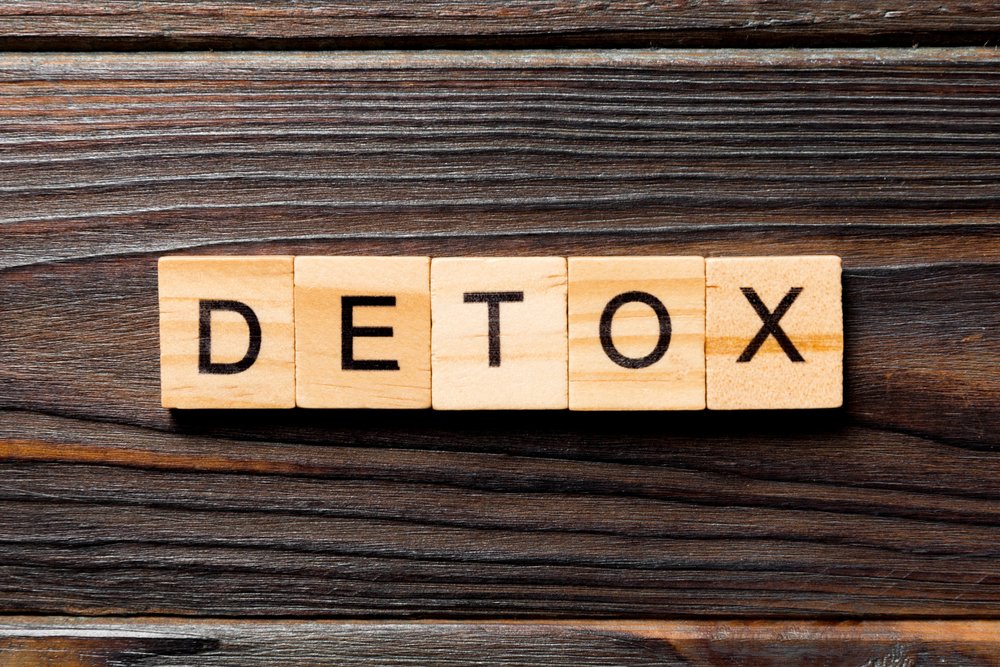
Detox isn’t just about gritting your teeth and pushing through; it’s a profound physical and mental recalibration as your body works to heal itself. It helps to think of it not as a test of willpower, but as a journey through a storm to reach calmer waters. This guide is here to map out the stages of detox, so you know what to expect from the first hours to the weeks that follow.
Your Guide to the Detox Journey
When your body grows dependent on a substance, its entire chemistry shifts to operate with that substance in its system. Take it away, and the brain and body are thrown into a state of shock, scrambling to adjust. That entire recalibration process is what we call withdrawal, and it unfolds in a series of predictable—though often intense—stages.
Think of it like this: imagine you’ve been leaning heavily against a wall for years. If that wall is suddenly yanked away, you’re going to stumble and flail as you fight to find your balance. Detox is that process of learning to stand on your own two feet again, and the experience is a little different for everyone. It’s shaped by a few key factors:
- The substance you used: The withdrawal process for alcohol is very different from opioids or benzodiazepines, each carrying its own timeline and risks.
- How long and how much you used: As you might expect, longer-term and heavier use often leads to a more intense and drawn-out withdrawal period.
- Your personal health: Your overall physical condition and any co-occurring mental health issues can play a big role in how you experience detox.
The Importance of a Roadmap
Trying to navigate detox without a clear idea of what’s coming can feel scary and isolating. Knowing what to expect—from the first wave of discomfort to the peak of the symptoms and the gradual return to feeling normal—is incredibly empowering. It turns a frightening, unpredictable ordeal into a manageable process with a clear beginning, middle, and end.
This guide is your roadmap. It’s here to shed light on each phase of the journey. Simply recognizing that feelings like intense anxiety or physical pain are temporary and expected parts of healing can be the one thing that helps you stay the course.
To give you a clearer picture, the table below outlines the general withdrawal timelines for several common substances. It’s important to remember that these are just estimates; your personal experience could be different. This is why medical supervision is so crucial—it ensures you can get through every stage as safely and comfortably as possible.
Overview of Detox Timelines by Substance
| Substance | Withdrawal Onset | Peak Symptoms | Typical Duration |
|---|---|---|---|
| Alcohol | 6-24 hours after last drink | 24-72 hours | 5-7 days |
| Short-Acting Opioids (e.g., Heroin) | 8-24 hours after last use | 48-72 hours | 4-10 days |
| Benzodiazepines (e.g., Xanax) | 1-4 days after last use | Within the first 2 weeks | Weeks to months |
While these timelines provide a solid framework, the intensity and specific symptoms within each stage are unique to the individual. Understanding this variability is key to being truly prepared for what lies ahead.
Stage One: The Start of Acute Withdrawal
This is where the detox journey truly begins. Known as acute withdrawal, this first stage kicks off shortly after the last time you used a substance.
Imagine your body has gotten used to a constant, blaring alarm going off every day. When that alarm suddenly shuts off, the silence feels strange, almost deafening. That’s a good way to think about what’s happening internally. Your body, now missing a substance it has come to rely on, triggers its own internal alarm system. This sets off a challenging, but necessary, process of getting back to normal.
This initial phase brings on a rush of physical and psychological symptoms. They’re the first signs that your body is fighting to find its natural balance again. It’s uncomfortable, for sure, but it’s a sign that healing has started.
A professional assessment is the first step in building a safe and effective plan, as this visual guide shows.

This just goes to show how vital a professional evaluation is right from the get-go, making sure your care is tailored to you from day one.
What to Expect in the First Hours and Days
Once acute withdrawal begins, a wide range of symptoms can surface, and it can feel pretty overwhelming. The most important thing to hold onto is that these feelings are temporary.
Here are some of the most common early withdrawal symptoms:
- Intense Cravings: Your brain is hardwired to expect the substance, and it will send powerful messages demanding you use again.
- Anxiety and Irritability: Without the substance to keep your mood on an even keel, you’ll likely feel restless, agitated, and anxious.
- Physical Discomfort: Think of a really bad flu. Sweating, tremors (often called “the shakes”), muscle aches, nausea, and vomiting are all common as your body works to clear the substance from its system.
- Insomnia: Sleep can feel impossible. Your nervous system is overactive and out of whack, making it incredibly difficult to rest.
The intensity of these early symptoms really depends on the specific substance you were using. This is exactly why going through detox alone isn’t just tough—it can be downright dangerous.
The acute withdrawal stage is when professional medical supervision is most critical. This isn’t a test of willpower. It’s a serious medical event that can lead to severe complications if you don’t have the right support.
Timelines Vary Significantly by Substance
If there’s one thing to understand about the stages of detox, it’s that there’s no universal timeline. When acute withdrawal starts, how long it lasts, and how intense it gets all come down to the specific drug, how long you’ve been using it, and your own personal health.
This is why a medically supervised withdrawal is so essential. For someone detoxing from alcohol, withdrawal can start within hours and peak between 24 to 72 hours. In severe cases, dangerous complications like delirium tremens can last up to 8 days.
For a short-acting opioid like heroin, symptoms usually show up 8 to 24 hours after the last use and can stick around for 4 to 10 days. For a deeper dive, take a look at our guide on how long it takes to detox from heroin. On the other hand, withdrawal from benzodiazepines might not even begin for 1 to 4 days, peaking in the first two weeks and sometimes lingering for months. This huge variability is exactly why personalized medical care is the only way to manage withdrawal safely.
Stage Two: Navigating Peak Withdrawal Symptoms
It helps to think of it as climbing a mountain. This is the steepest, most difficult part of the ascent, but reaching the summit means the path forward gets easier. While it’s incredibly challenging, this peak intensity is a clear signal that your body is fighting hard to heal and find its balance again.
The Peak Experience Varies by Substance
What this “peak” feels like depends entirely on the substance you’re detoxing from. Each one presents a completely different set of challenges, which is why professional, specialized support is so crucial.
- Alcohol Withdrawal: This can be one of the most dangerous detoxes. When your central nervous system is no longer suppressed by alcohol, it can rebound with a vengeance. This can trigger severe tremors, hallucinations, and even a life-threatening condition known as delirium tremens (DTs), which causes dangerous shifts in breathing and circulation.
- Opioid Withdrawal: People often describe the peak of opioid withdrawal as the worst flu imaginable, magnified tenfold. You’re looking at severe muscle aches, stomach cramps, nausea, and vomiting. While it’s not typically life-threatening, the physical misery is so extreme that getting through it without medical help is incredibly difficult. For a deeper dive, check out our guide on how long heroin stays in your system.
- Benzodiazepine Withdrawal: Much like alcohol, coming off benzodiazepines can be risky. Peak symptoms often bring on overwhelming anxiety, panic attacks, insomnia, and a very real risk of seizures. The psychological toll during this phase can feel completely unbearable.
These stark differences make it clear: a one-size-fits-all approach to detox just doesn’t work. It’s not just ineffective—it’s unsafe.
Medical Intervention Is Not Optional—It Is Essential
At this stage, having medical supervision isn’t just a good idea; it’s absolutely necessary. This isn’t about “toughing it out.” It’s about safely managing a serious medical crisis.
Healthcare professionals use specific, proven medications to manage symptoms, keep you safe, and provide as much comfort as possible. For instance, with alcohol withdrawal, doctors often use benzodiazepines to prevent seizures and calm the overstimulated nervous system. For opioid withdrawal, medications like buprenorphine or clonidine can dramatically reduce the brutal flu-like symptoms and cravings, making the process much more manageable.
The goal of medical intervention is to stabilize the body and mind, preventing dangerous complications and alleviating the profound suffering that can otherwise derail the recovery process. It provides a bridge through the most difficult part of the journey.
Recent studies show just how critical this support is. Hospitalizations for alcohol withdrawal syndrome (AWS) are most common in people aged 40 to 49. On top of that, men between 18 and 39 are hospitalized for AWS over six times more often than women in the same age group, highlighting a clear need for targeted care.
Overcoming the Psychological Hurdles
The physical fight is only half the story. Peak withdrawal also unleashes a storm of psychological challenges. Cravings can become all-consuming, joined by intense feelings of anxiety and despair. It’s easy to feel like the misery will never end, which creates a powerful temptation to use again just to make it stop.
This is where a professional detox setting truly shines. Coping strategies are woven directly into your care plan to help you navigate the mental and emotional turmoil.
Here are a few effective techniques used in detox facilities:
- Mindfulness and Breathing Exercises: Simple exercises can ground you in the present, pulling you out of the overwhelming cycle of anxiety and cravings.
- Supportive Counseling: Just talking to a therapist provides an outlet for the fear and frustration, reminding you that you aren’t alone in this.
- Distraction Techniques: Sometimes, the best thing you can do is give your brain a break. Engaging in simple activities like listening to music, watching a movie, or reading can offer a much-needed escape from the intensity of it all.
Getting through this stage is arguably the toughest part of detox. But by understanding what’s coming and relying on professional medical and psychological support, you can get through the storm safely and emerge on the other side, ready for the next phase of your healing.
The Clinical Side of Managing Detox

Going through a medically supervised detox is about much more than just having a safe space to get through it. It’s a hands-on, clinical process designed to manage the very real physiological storm that withdrawal kicks up in the body.
When your body has grown dependent on a substance, taking it away suddenly can send your vital systems into absolute chaos. This isn’t just a matter of feeling uncomfortable; it’s a serious medical situation that demands constant, careful attention.
Professional detox facilities are built for this. They are command centers, staffed with experts who use specific medical tools to track your health in real time. They keep a close watch on your body’s most critical functions as it fights to find its balance again. This meticulous level of care is what makes it possible to navigate the riskiest stages of detox without harm.
Monitoring Your Body’s Most Vital Systems
Withdrawal puts an incredible amount of strain on the body. Your heart, liver, and other vital organs are working overtime and are especially vulnerable during this period. To keep you safe, medical teams use a lineup of assessments to get a precise, moment-by-moment picture of what’s happening inside. It’s a data-driven approach that lets them spot trouble before it escalates.
Here’s a look at what they’re monitoring:
- Cardiac Monitoring (ECG/EKG): An electrocardiogram is used to track the heart’s electrical rhythm. Clinicians are looking for any red flags, like arrhythmias or other irregularities that can signal serious complications.
- Liver Function Tests (LFTs): These are simple blood tests that measure key enzymes and proteins, giving a clear snapshot of your liver’s health. The liver acts as the body’s main filter, and it often takes a beating during active substance use—withdrawal can add even more stress.
- Blood Work: Beyond the liver, comprehensive blood panels give a full report on everything from your electrolyte balance to kidney function, making sure your body’s core chemistry stays stable.
This kind of constant oversight takes the mystery and fear out of the process. It replaces anxiety with the reassurance that you are being cared for by people who know exactly what to look for. Understanding https://addictionhelplineamerica.com/the-role-of-detox-in-rehab/ really brings home the point that this first step is all about getting you medically stable.
Translating Complex Data into Patient Safety
The physical changes your body goes through during detox are incredibly complex, but the reason for monitoring them is simple: to keep you safe. For example, diagnostic tests help the clinical team understand the degree of physical dependence and how it’s affecting you. A urinalysis might show byproducts that point to muscle strain or metabolic issues, while specific markers in your blood can alert them to potential stress on your heart.
By translating these complex medical data points into actionable care, a clinical team can effectively manage symptoms and prevent life-threatening complications. This proactive approach is the cornerstone of a safe and successful detox.
Ultimately, this level of clinical management underscores a non-negotiable fact: detox is a medical procedure. It demands the same expertise and attention as any other serious health condition. Knowing what to expect from a quality program empowers you to advocate for the standard of care you deserve, creating a foundation of safety and trust right from the start of your recovery.
Stage Three: Understanding Post-Acute Withdrawal
Just when you think you’ve made it through the worst of withdrawal, another, quieter challenge often emerges. You’ve weathered the intense physical storm of the acute phase, but now you might be entering what’s known as Post-Acute Withdrawal Syndrome, or PAWS. This is easily one of the most misunderstood parts of detox, and getting a handle on it is absolutely key to staying the course.
Think of it this way: acute withdrawal is like a hurricane. It’s violent, loud, and you can’t ignore it. PAWS is more like the unpredictable weather that follows for weeks or months—lingering clouds, sudden downpours, and unexpected patches of sun. The immediate, life-threatening danger is gone, but the environment is still far from stable.
This happens because your brain is deep in the process of healing itself. After being dependent on a substance, its natural chemistry is completely thrown off. PAWS is the direct result of your brain slowly, painstakingly recalibrating its neurotransmitters—like dopamine and serotonin—to function on their own again. It’s a sign that you’re healing, even when it feels frustratingly difficult.
What Does PAWS Actually Feel Like?
Unlike the raw, constant intensity of acute withdrawal, PAWS symptoms tend to come and go in waves. This is what makes it so confusing. One day you might feel fantastic, like your old self again, only to wake up the next day feeling emotionally raw and foggy. This unpredictable, episodic nature is the hallmark of PAWS.
People often report experiencing a cluster of symptoms, including:
- Mood Swings: You might find yourself swinging from hopeful and happy to irritable, anxious, or deeply sad without any obvious reason.
- Anxiety and Panic: A low-grade, persistent feeling of unease can hang around, sometimes punctuated by sudden, overwhelming moments of panic.
- Low Energy and Fatigue: It’s a bone-deep exhaustion that makes even simple tasks feel like climbing a mountain.
- Sleep Disturbances: Falling asleep, staying asleep, or dealing with vivid, unsettling dreams are all common complaints.
- Cognitive Issues: Many people describe a “brain fog” that makes it hard to concentrate, remember things, or solve problems.
This phase can last for a few weeks, several months, or in some cases, even longer. How long it sticks around really depends on the substance you were using, how long you used it, and your own unique physiology. For a closer look at how timelines can differ, our guide on the alcohol withdrawal timeline offers a more detailed breakdown.
Post-Acute Withdrawal Syndrome is not a sign that you’re failing or that something is wrong with you. It is a normal, physiological part of the brain’s long-term healing process as it rewires itself for a life without substances.
Strategies for Managing This Extended Stage
Getting through PAWS means shifting your focus from just surviving the moment to building long-term wellness. Since the symptoms are mostly psychological and emotional, your coping skills have to adapt. The goal is to build resilience and create a stable, supportive environment where your brain can continue to heal.
Here are a few practical strategies that can make all the difference:
- Establish a Solid Routine: Predictability is your best friend right now. A consistent daily schedule for meals, exercise, and sleep helps stabilize your mood and cuts down on decision fatigue. Something as simple as waking up and going to bed at the same time every day can work wonders for your sleep cycle.
- Prioritize Stress Management: Stress is a massive trigger for PAWS symptoms, so you have to be proactive about managing it. Find what works for you—it could be mindfulness meditation, deep breathing exercises, yoga, or just spending quiet time in nature.
- Engage in Consistent Support: You cannot do this alone. Ongoing therapy, counseling, and support groups like AA or SMART Recovery are lifelines. Talking to people who genuinely understand what you’re going through is incredibly validating and helps combat the isolation that often comes with this phase.
- Practice Self-Compassion: Be kind to yourself. Recovery isn’t a straight line; it’s full of ups and downs. A bad day doesn’t mean you’re back at square one. Acknowledge that PAWS symptoms are a normal part of the process, not a personal failure.
When you understand that these lingering symptoms are a predictable part of the recovery landscape, you can prepare for them. Instead of being blindsided by a wave of anxiety or fatigue, you can recognize it for what it is—a temporary sign that your brain is still healing. This knowledge empowers you, turning a potentially discouraging experience into a manageable part of your journey toward lasting recovery.
From Detox to Lasting Recovery: What Comes Next?
Making it through detox is a massive accomplishment. Seriously, take a moment and recognize the strength that took. It’s like guiding a ship through a hurricane and finally reaching the calm waters of the harbor. The storm is over, but the ship needs repairs and you need to learn how to navigate the open ocean on your own.
Detox deals with the physical side of things—it gets your body stable and clears your head from the immediate fog of substance use. But it doesn’t magically fix the reasons why addiction took hold in the first place. That’s the next chapter. Lasting recovery is built by digging into those root causes, and that journey starts the moment detox ends.
Your Aftercare Plan: The Roadmap to a New Life
Think of your aftercare plan as the GPS for your recovery journey. It’s a structured, personalized guide designed to keep you supported as you build a new life, one that doesn’t revolve around substances. This is where the real healing happens, moving past the physical fight and into strengthening your mind and spirit. A solid plan isn’t just a nice idea—it’s the most critical piece for turning a successful detox into a successful life.
A strong aftercare plan almost always includes a few key elements:
- Continued Treatment: This often means stepping into an inpatient or outpatient rehab program. Here, you get to do a deep dive into the psychology behind addiction.
- Individual Therapy: Working one-on-one with a counselor is your space to unpack personal triggers, learn healthier ways to cope, and work through any underlying trauma.
- Peer Support Groups: There’s incredible power in shared experience. Groups like Alcoholics Anonymous (AA) or SMART Recovery provide a community that gets it, offering connection and accountability when you need it most.
The whole point of aftercare is to give you the skills, the support system, and the resilience to stay sober for the long haul. Detox gets you to the starting line; aftercare is how you run the marathon.
Building a Life Worth Protecting
This next phase is about so much more than just not using. It’s about creating a life that is so rich, so meaningful, and so genuinely fulfilling that substances simply lose their appeal.
By sticking with therapy and leaning on your support network, you start learning how to handle life’s curveballs, mend broken relationships, and discover a new sense of purpose. The road after detox isn’t always easy, but it is absolutely filled with hope and the real possibility of a brighter future. The foundation you build right now is what you’ll stand on for the rest of your life.
Common Questions About the Stages of Detox
When you’re first learning about detox, a lot of questions pop up about how long it takes, if it’s safe, and what to expect afterward. Getting straight answers is the best way to feel more prepared for what’s ahead, whether you’re considering it for yourself or someone you care about.
Let’s walk through some of the most common questions people ask about the withdrawal journey.
Can I Go Through the Stages of Detox at Home Safely?
This is a big one, and the answer is usually no. Trying to detox from certain substances on your own can be incredibly dangerous.
With alcohol and benzodiazepines, for example, stopping abruptly can lead to life-threatening issues like seizures, delirium tremens (the “DTs”), and extreme dehydration. These aren’t risks you want to take a chance on.
A medically supervised detox center is a safe space where healthcare professionals watch over you around the clock. They can provide medications to make you more comfortable, manage dangerous symptoms, and handle any emergencies immediately. This kind of expert support makes the process not only safer but also increases your chances of getting through it successfully.
How Long Do All the Stages of Detox Usually Take?
There’s no single timeline that fits everyone. The length of your detox really depends on your unique situation—what substance you were using, for how long, and your overall health.
That said, the most intense part, the acute withdrawal phase, typically lasts between 5 to 14 days. But the process doesn’t just stop there.
It’s so important to know that a second, longer phase called Post-Acute Withdrawal Syndrome (PAWS) often follows. You won’t feel as physically sick, but you might deal with nagging symptoms like mood swings and sleep issues for months as your brain slowly rebalances itself.
This is exactly why ongoing support after the initial detox period is a non-negotiable for long-term recovery.
What Happens Immediately After I Finish Detox?
Making it through detox is a huge accomplishment, but think of it as graduating from boot camp, not winning the war. The real work of recovery starts right after your body is stable. Now, the focus has to shift from getting physically well to healing the psychological side of addiction.
This next step almost always means transitioning directly into a structured treatment program. The most common paths include:
- Checking into an inpatient or residential rehab facility.
- Starting an outpatient program while living at home.
- Beginning one-on-one and group therapy.
- Joining a peer support group like Alcoholics Anonymous (AA) or SMART Recovery.
An aftercare plan isn’t just a suggestion; it’s your lifeline. Cravings, for instance, don’t just disappear once detox is over. You can learn more about what to expect by reading our guide on how long cravings typically last. This is the phase where you build the real-world skills and support system you need to protect the incredible progress you’ve already made.
The path to recovery is a journey, and you don’t have to walk it alone. If you or someone you care about is struggling, Addiction Helpline America is here to provide confidential support and guidance 24/7. Call us to find the help you need to take the first step toward a healthier life. Visit us at https://addictionhelplineamerica.com.
Our helpline is 100%
free & confidential
If you or someone you care about is struggling with drug or alcohol addiction, we can help you explore your recovery options. Don’t face this challenge alone—seek support from us.
Programs
Resources
Will my insurance
cover addiction
treatment?
We're ready to help
Find the best
drug or alcohol treatment
center
Are you or a loved one struggling with addiction? Call today to speak to a treatment expert.












